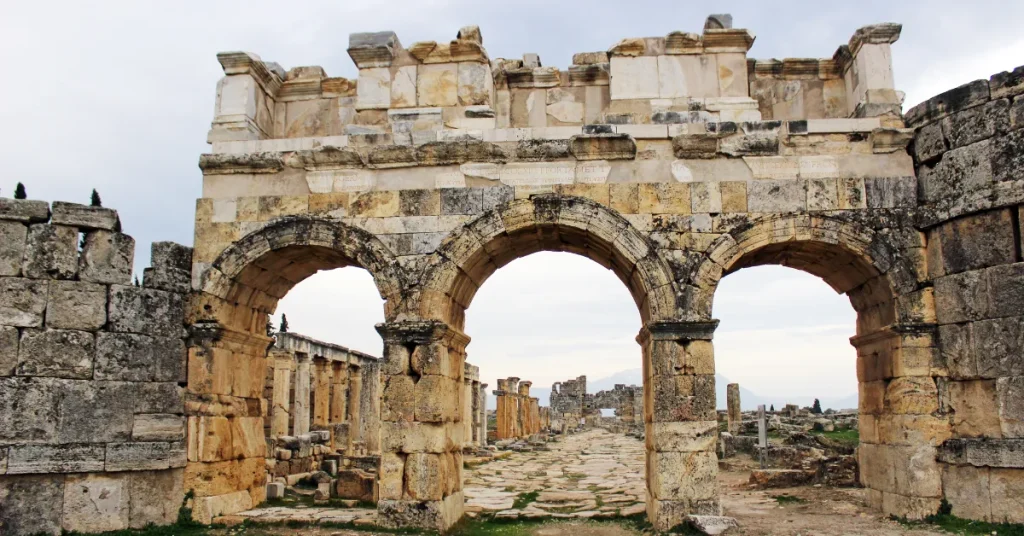A depth of 15 cubits is approximately 22.5 feet or 6.858 meters. This measurement comes from an ancient unit called the cubit.
Exploring various measurements and units of depth often leads to the question of just how deep 15 cubits is.
The cubit, an ancient unit of length used by diverse civilizations including the ancient Egyptians and Babylonians, has made its way into historical texts, architecture, and even biblical references.
One of the most famous mentions of the cubit is in the construction of Noah’s Ark, which was measured using this very unit — indicative of its antiquity and cultural relevance.
While the exact length of a cubit can vary slightly depending on the historical context and geographical region, the standard cubit is generally accepted as 18 inches (45. 72 cm).
To translate cubits into modern measurements, multiplying the number of cubits by 18 inches gives us a tangible understanding of just how significant this ancient measure was in shaping historical structures and artifacts.

The Mystery Of Cubits
The ancient measurement known as the cubit sparks fascination and curiosity.
Its mystery lies in its variation across different cultures and eras.
Exploring the depth of 15 cubits unveils a window into historical architecture and religious texts.
Defining The Cubit
What exactly is a cubit? It’s an early unit of length based on the human forearm.
From the elbow to the tip of the middle finger, this measurement has served as a builder’s tool.
A standard cubit typically ranges from 18 to 21 inches.
Thus, calculating 15 cubits involves multiplying this length by 15.
- 18 inches cubit: 15 x 18 inches = 270 inches or 22.5 feet
- 21 inches cubit: 15 x 21 inches = 315 inches or 26.25 feet
Historical Significance
The cubit’s use can be traced back to civilizations like the Egyptians and Babylonians.
- Used in building the Pyramids
- Referenced in the construction of Noah’s Ark
- Invaluable in archaeological studies
The Great Pyramid of Giza’s dimensions involve cubit measurements, introducing precision to ancient engineering.
Noah’s Ark, as described in the Bible, measured 300 cubits long.
That’s why knowing how deep 15 cubits are helps us imagine its grand scale.
Comparison With Modern Units
Hearing “15 cubits” might sound old and confusing. But let’s make it clear and simple! Cubits are an ancient measure, like a foot or a yard today. Imagine your arm from fingers to elbow; that’s a cubit. Now, let’s compare cubits to inches and centimeters.
Cubits Versus Inches And Centimeters
A Cubit can change length depending on the person’s arm. In ancient times, a standard cubit was about 18 inches or 45 centimeters. That’s bigger than a foot ruler! Let’s dive deep into modern measurements.
| Cubit | Inches | Centimeters |
| 1 | 18 | 45 |
- How wide is your doorway? It’s about two to three cubits wide.
- A baseball bat? Roughly a cubit long.
Converting 15 Cubits To Modern Metrics
Let’s turn the old 15 cubits into units we use every day. That’s like converting a VHS to a digital movie. Really simple, right?
- First, take the 15 cubits.
- Second, multiply by 18 inches for each cubit.
That means 15 cubits equals 270 inches. Big, isn’t it?
In centimeters, 15 cubits is a whooping 675 centimeters. That’s taller than most doorways!
Applications In Ancient Architecture

In the realm of ancient architecture, the cubit reigned as a key unit of measurement. Understanding how deep 15 cubits is provides insight into the construction of remarkable edifices from long ago.
Architects and builders of ancient times relied heavily on the cubit to create structures that have stood the test of time.
Famous Constructions Using Cubits
Ancient builders’ expertise is evident in iconic structures:
- The Great Pyramid of Giza – Its dimensions root in cubits.
- The Temple of Karnak – This showcases precise cubit usage.
- Babylon’s Walls – They exemplify cubit-based defense structures.
These constructions illustrate the cubit’s significance in design and execution.
Precision In Ancient Building Techniques
Ancient architects demonstrated remarkable precision:
- Alignment with stars using cubit measurements was precise.
- Cubit rods ensured uniform length throughout construction.
- Stone cutting techniques were perfected using cubit references.
Their skill allowed for the creation of structures that endure centuries.
| Structure | Estimated Cubits Used |
| Great Pyramid | 440 cubits (base) |
| Luxor Temple | Varied measures per section |
| Hanging Gardens | Not fully known, but substantial |
| Ancient City Walls | Diverse, depending on city |
To this day, the legacy of their architectural prowess amazes scholars and tourists alike. They meticulously applied their measurement technique, the cubit, to lay the foundations for monuments we marvel at.
The cubit was more than just a unit of length; it was a cornerstone of civilization’s most monumental feats.
Symbolism In Historical Texts
Delving into historical texts reveals a treasure trove of symbolism. Measures like cubits often carry deeper meanings beyond their practical use. These ancient units tell stories of cultures, beliefs, and the mysteries of old.
Symbolism in historical texts often intertwines the literal with the metaphorical, creating layers of interpretation for scholars and enthusiasts alike.
Cubits In Religious Scriptures
The cubit, an ancient unit of length based on the forearm, holds a prominent place in religious scriptures. It sets the base for many sacred structures described in texts:
- Noah’s Ark: Measured 300 cubits long, 50 cubits wide, and 30 cubits high.
- Temple of Solomon: Its dimensions included multiple references to cubits.
- Ark of the Covenant: Carried dimensions of 2.5 cubits in length and 1.5 in height and width.
These measurements are not just figures; they symbolize order, divine proportions, and the connection between humanity and the divine. Understanding their symbolism offers insights into spiritual and worldly views of ancient societies.
Cubit: A Measure Beyond The Physical
A cubit can represent more than physical distance. It reflects human physiology, societal standards, and even philosophical conceptions:
| Aspect | Symbolism |
| Human Body | Connection to human scale and practicality |
| Societal Norms | Standardization based on average dimensions |
| Philosophical Ideas | Representation of balance and harmony |
In many cultures, the cubit symbolizes not just physical measures, but also a harmonious balance in architecture, art, and life. The cubit transcends its basic function, turning a simple measurement into a tool of symbolic significance intertwined throughout history.
Recreating Ancient Measurements Today

In today’s world, we often take for granted the precision of our measuring tools. But what about the ancient measurements, such as the cubit? Mentioned in historical texts, the cubit can seem mysterious.
What would 15 cubits look like using today’s standards? To answer that, let’s dive into the fascinating world of recreating ancient measurements in our modern era.
Experimental Archaeology
Experimental archaeology breathes life into old measures. Scholars and enthusiasts alike undertake the task of converting the cubit into modern units. A cubit was roughly the length from the elbow to the tip of the middle finger.
Historic records indicate one Egyptian royal cubit was about 52.4 centimeters or 20.6 inches. So, 15 cubits would be approximately 786 centimeters or 309 inches.
| Cubits | Centimeters | Inches | Feet |
| 15 | 786 | 309 | 25.75 |
Educational Value
Learning through doing makes history tangible. Reenacting ancient measuring brings a hands-on approach to education. Students can craft their cubit rods and measure objects around them.
This practice not only teaches about ancient units but also sharpens math skills and sparks curiosity in history.
- Understanding historical contexts
- Improving practical mathematics
- Developing problem-solving abilities
- Encouraging creative learning methods
Modern Relevance
The cubit’s relevance persists, even in our high-tech age. It allows comparison between ancient and modern construction techniques. For example, the Noah’s Ark was measured in cubits, prompting debates about its size.
The cubit thus bridges past and present, offering insights into the construction feats of ancient civilizations.
- Comparing ancient and modern engineering
- Analyzing historical texts and structures
- Assessing the accuracy of archaeological reconstructions
FAQs About How Deep Is 15 Cubits
What Is The Measurement Of 15 Cubits?
15 cubits is an ancient measurement equating to approximately 22. 5 feet or 6. 858 meters. It’s based on the forearm length, from the tip of the middle finger to the elbow.
How Deep Would 15 Cubits Be Underwater?
Underwater, 15 cubits would measure around 22. 5 feet deep. This depth is significant in historical contexts, particularly in biblical accounts such as Noah’s Ark.
Can You Convert 15 Cubits To Modern Units?
Yes, 15 cubits can be converted to modern units. Specifically, it is equal to about 22. 5 feet (ft) or roughly 6. 858 meters (m), providing a tangible reference for contemporary understanding.
What Significance Does 15 Cubits Hold Historically?
Historically, 15 cubits is often referenced in ancient texts, such as the Bible’s account of the flood, indicating the depth at which the Ark floated above the mountains.
Conclusion
Understanding the depth of 15 cubits has taken us from biblical history to modern measurements. This exploration proves that ancient units retain relevance today.
Whether for educational insights or sheer curiosity, grasping these dimensions enriches our perception of historical contexts.
Dive into your next topic with just as much enthusiasm and precision!
Resources:
1. https://www.usgs.gov/faqs/how-can-i-find-depth-water-table-a-specific-location
